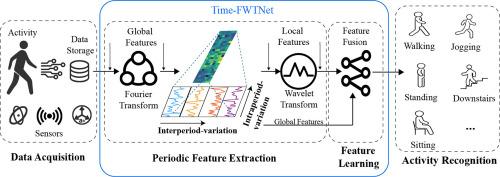一种基于周期特征的可穿戴传感器人体活动识别特征提取框架
IF 3
3区 工程技术
Q2 ENGINEERING, ELECTRICAL & ELECTRONIC
引用次数: 0
摘要
人体活动识别(HAR)广泛应用于各个领域,其准确性和鲁棒性至关重要。然而,现有方法主要侧重于提取时空特征,未能充分利用人类活动中存在的复杂周期性特征。人类行为通常包含显著的周期性模式。如果不能有效地捕获这些周期性特征,将限制模型处理复杂行为的性能,从而影响识别的准确性和泛化能力。为了解决这一问题,本文提出了一种周期性特征提取的网络框架time - fwtnet。该网络结合傅里叶变换提取全局周期特征。FWT-Block模块用于分解全局特征和提取局部周期特征,使HAR方法能够同时关注全局和局部周期特征。此外,我们提出了frequency - cm来分解高频和低频成分以进行目标特征学习,同时使用小卷积核扩展接受域。为了验证Time-FWTNet的性能,我们在一个构建的数据集和三个公共数据集上进行了实验。实验结果表明,Time-FWTNet在ust - har、USC-HAD、UCL-HAPT和PAMAP2数据集上的平均准确率分别为98.89%、98.81%、98.76%和98.72%。本文章由计算机程序翻译,如有差异,请以英文原文为准。

A novel feature extraction framework based on periodic features for human activity recognition using wearable sensor data
Human Activity Recognition (HAR) is widely applied in various fields, where its accuracy and robustness are crucial. However, existing methods primarily focus on extracting spatiotemporal features, failing to fully utilize the complex periodic features present in human activities. Human behavior typically involves significant periodic patterns. Failure to effectively capture these periodic features can limit the model’s performance in handling complex behaviors, thereby affecting the accuracy and generalization ability of recognition. To address this issue, this paper proposes a network framework for periodic feature extraction—Time-FWTNet. This network integrates Fourier Transform to extract global periodic features. The FWT-Block module is designed to decompose global features and extract local periodic features, enabling the HAR method to simultaneously focus on both global and local periodic characteristics. Additionally, we propose Freq-CM to decompose high-frequency and low-frequency components for targeted feature learning, while expanding the receptive field with small convolution kernels. To verify the performance of Time-FWTNet, we conduct experiments on a constructed dataset as well as three public datasets. The experimental results show that Time-FWTNet achieves average accuracies of 98.89 %, 98.81 %, 98.76 %, and 98.72 % on the AUST-HAR, USC-HAD, UCL-HAPT, and PAMAP2 datasets, respectively.
求助全文
通过发布文献求助,成功后即可免费获取论文全文。
去求助
来源期刊

Digital Signal Processing
工程技术-工程:电子与电气
CiteScore
5.30
自引率
17.20%
发文量
435
审稿时长
66 days
期刊介绍:
Digital Signal Processing: A Review Journal is one of the oldest and most established journals in the field of signal processing yet it aims to be the most innovative. The Journal invites top quality research articles at the frontiers of research in all aspects of signal processing. Our objective is to provide a platform for the publication of ground-breaking research in signal processing with both academic and industrial appeal.
The journal has a special emphasis on statistical signal processing methodology such as Bayesian signal processing, and encourages articles on emerging applications of signal processing such as:
• big data• machine learning• internet of things• information security• systems biology and computational biology,• financial time series analysis,• autonomous vehicles,• quantum computing,• neuromorphic engineering,• human-computer interaction and intelligent user interfaces,• environmental signal processing,• geophysical signal processing including seismic signal processing,• chemioinformatics and bioinformatics,• audio, visual and performance arts,• disaster management and prevention,• renewable energy,
 求助内容:
求助内容: 应助结果提醒方式:
应助结果提醒方式:


